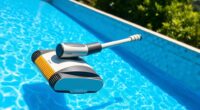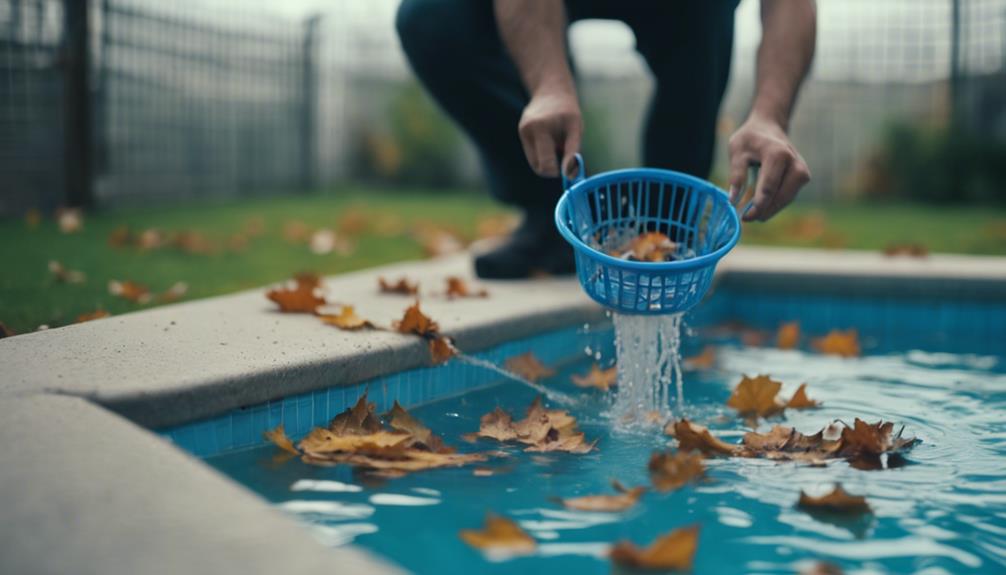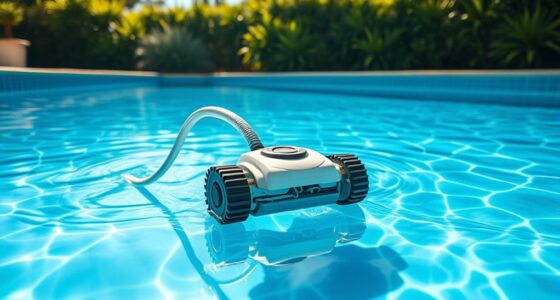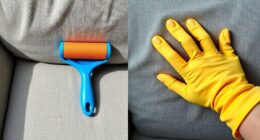Suction pool cleaners work by connecting to your pool’s skimmer or suction port, using the existing filtration system to generate a vacuum that pulls in debris. They move across the pool surface, guided by hoses and sensors, while the pump creates hydraulic force to lift leaves, dirt, and particles into a debris bag. Proper maintenance of the system guarantees efficient cleaning. To discover how these components work together, keep exploring further details.
Key Takeaways
- They connect to the pool’s skimmer or suction port via a hose, creating a water flow that powers movement and debris collection.
- A high-performance motor generates hydraulic pressure, enabling the cleaner to move across the pool surface and suction debris into its bag.
- Sensors and navigation algorithms help the cleaner detect surfaces, walls, and obstacles, ensuring systematic coverage of the pool area.
- Water circulation distributes filtered water evenly, while the debris bag traps leaves, twigs, and particles to prevent clogging.
- Regular maintenance of filters, hoses, and debris chambers maintains optimal suction power and cleaning efficiency.
Basic Components of a Suction Pool Cleaner

A suction pool cleaner relies on several key components working together to keep your pool spotless. The first is the hose, which connects the cleaner to your pool’s skimmer or dedicated suction port, allowing water and debris to flow through. The cleaner’s body moves along the pool lining, guided by these hoses, collecting dirt and debris. Inside, a debris bag traps leaves, twigs, and other particles, preventing clogs and making disposal easy. The debris bag is vital for maintaining efficiency and preventing debris from re-entering the pool water. The cleaner’s design ensures it glides smoothly over the pool lining, picking up debris as it goes. Additionally, modern suction pool cleaners often incorporate high-performance motors that enhance cleaning speed and effectiveness. These motors are designed to operate efficiently with energy-efficient systems, reducing overall power consumption.
How Suction Power Is Generated and Maintained
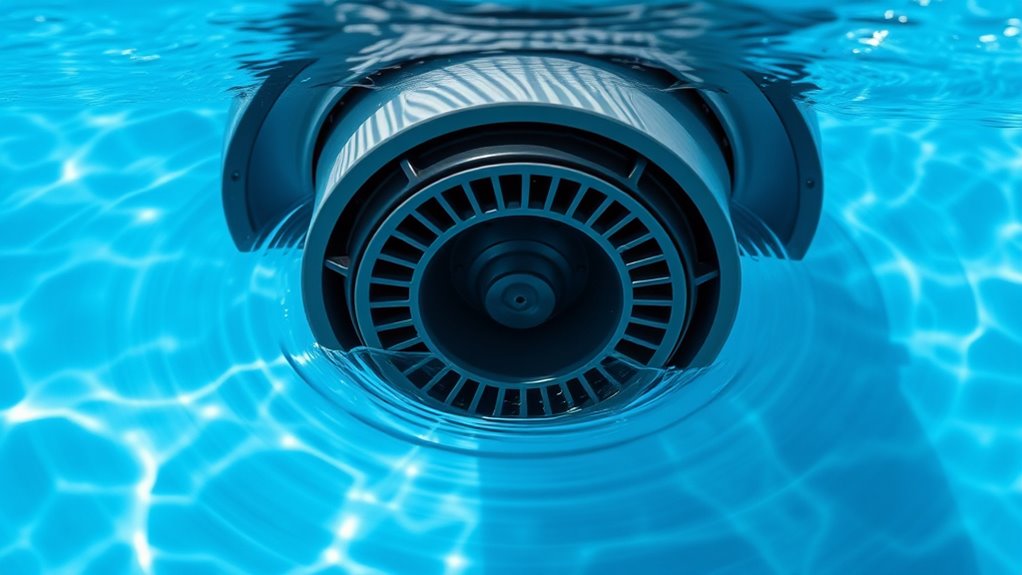
Suction power in pool cleaners is generated by the pool’s existing filtration system, which creates a vacuum that pulls water and debris through the hose and into the debris bag. To maintain consistent suction, you should:
- Follow your cleaning schedule regularly, preventing debris buildup that can weaken suction.
- Check for clogs or obstructions in the hose or debris bag.
- Compare manufacturer recommendations, as some models need specific maintenance routines.
- Replace worn-out or damaged parts promptly to guarantee maximum suction power.
Understanding how suction is generated helps you keep your pool cleaner working efficiently. When comparing different models, pay attention to how each manufacturer maintains suction strength over time. Proper maintenance and informed choices ensure your pool stays clean with minimal effort.
The Role of the Pump and Filtration System
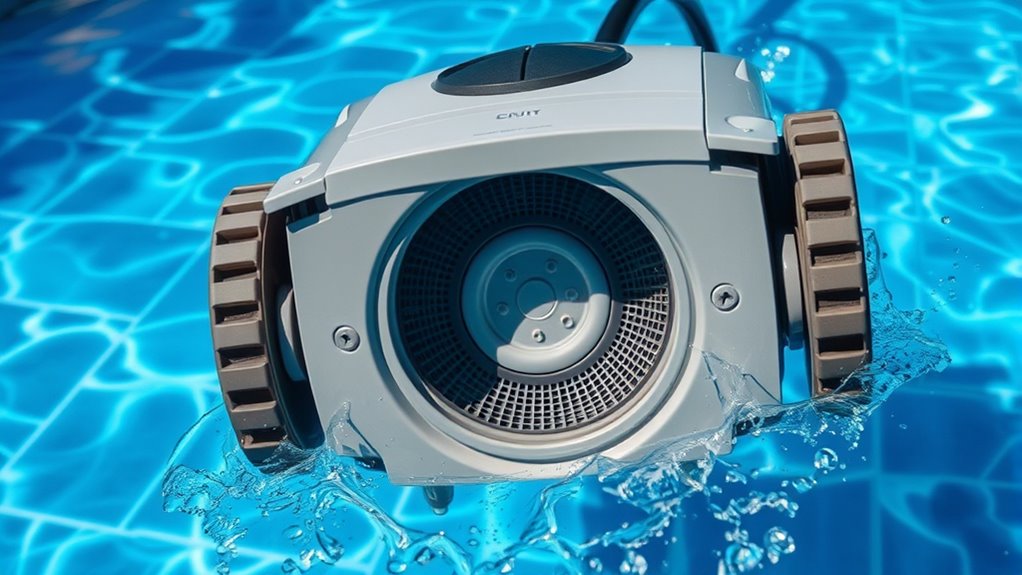
The pump power mechanism is the heart of your pool cleaner, driving water through the system with essential force. The filtration efficiency process guarantees debris is captured effectively, keeping your pool clean and clear. Water circulation dynamics then distribute cleaned water evenly, maintaining crucial pool hygiene. Additionally, automation technology can enhance the overall performance of pool cleaning systems by optimizing water flow and debris removal processes. Implementing remote monitoring capabilities can further improve efficiency by allowing users to oversee and adjust cleaning operations remotely. Incorporating advanced sensors can also improve detection of debris and ensure thorough cleaning coverage. Understanding the water circulation dynamics helps optimize the system’s efficiency and prolong its lifespan, especially when considering how glycolic acid in skincare promotes pore refinement and skin health, which parallels the importance of proper circulation for overall system performance.
Pump Power Mechanism
Ever wondered how suction pool cleaners efficiently remove debris from your pool? It all comes down to the pump power mechanism. The pump creates hydraulic pressure, which pulls water and debris into the cleaner. Here’s how it works:
- The motor powers the pump, generating strong hydraulic pressure.
- This pressure draws debris-laden water through the cleaner’s intake.
- Pump efficiency determines how effectively water is moved without wasting energy.
- The vacuum’s suction force relies on a balance between hydraulic pressure and flow rate.
A well-designed pump maximizes hydraulic pressure, ensuring debris is captured quickly. Proper pump efficiency means less energy consumption and more cleaning power. This synergy of pressure and efficiency keeps your pool spotless and minimizes wear on the system, making your cleaning routine smoother and more effective. Enhancing pump performance can lead to more reliable and powerful cleaning results, especially when combined with advanced filtration system technologies that trap even the smallest particles. Additionally, maintaining optimal filter cleanliness ensures sustained pump efficiency and prolongs equipment lifespan. Regular maintenance of the pump components can prevent common issues and sustain peak performance, including checking for blockages or leaks that may impair hydraulic pressure.
Filtration Efficiency Process
Have you ever wondered how your pool stays crystal clear despite continuous debris? It all comes down to the filtration efficiency process. Your pump pulls water from the pool, passing it through chemical filtration to remove contaminants and particles. This step is vital for maintaining water quality and clarity. UV sterilization plays a key role by destroying bacteria, algae, and viruses without chemicals, ensuring safe, sanitized water. The pump’s power circulates water through these systems repeatedly, preventing debris buildup and keeping your pool inviting. Regular maintenance of the filtration system guarantees maximum performance. Additionally, understanding the filtration process helps in optimizing pool cleanliness and longevity. By combining chemical filtration and UV sterilization, your suction pool cleaner effectively preserves water cleanliness, reduces chemical use, and prolongs the life of your pool equipment.
Water Circulation Dynamics
Understanding how your pool stays clean depends on how effectively the pump and filtration system work together to circulate water. Water flow patterns determine how debris and contaminants move through the pool, impacting suction optimization. Proper circulation ensures the suction pool cleaner can effectively pick up dirt. To optimize this process, consider these factors:
- Position skimmers and returns for balanced water flow.
- Maintain the pump’s flow rate for steady circulation.
- Use directional eyeballs to direct water where needed.
- Regularly clean filters to prevent blockages.
- Ensuring consistent water circulation enhances the overall efficiency of your pool cleaning system. Additionally, incorporating AI security solutions can help monitor and optimize your pool equipment’s performance through real-time diagnostics and alerts. Proper water flow patterns are essential to prevent stagnant areas and ensure all debris is effectively captured.
Movement and Navigation Mechanisms
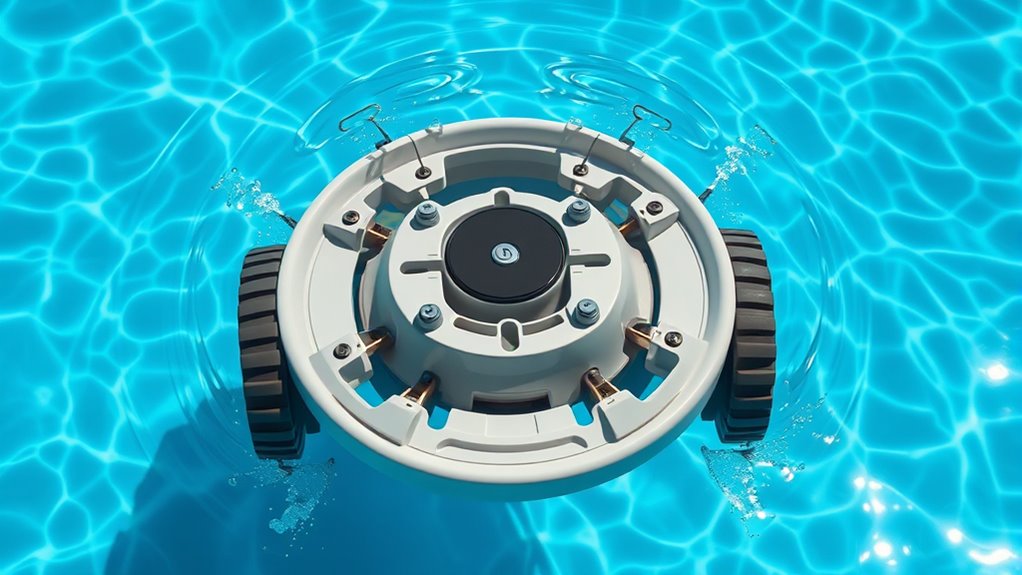
You’ll notice that suction pool cleaners use smart pathfinding algorithms to efficiently cover your pool’s surface. Surface detection techniques help them recognize walls and obstacles, preventing missed spots. Understanding these mechanisms shows how they navigate seamlessly and clean thoroughly. Additionally, some models incorporate sensor technology to adapt to varying pool shapes and ensure comprehensive cleaning.
Pathfinding Algorithms
Pathfinding algorithms are essential for ensuring suction pool cleaners navigate efficiently and thoroughly across pool surfaces. They enable robotic navigation and obstacle avoidance, preventing missed spots and collisions. To achieve this, the algorithms typically:
- Map out the pool’s layout to plan a systematic cleaning route
- Adjust paths dynamically when encountering obstacles or irregular surfaces
- Use sensors to detect walls and objects, refining navigation in real-time
- Optimize movement patterns for maximum coverage with minimal overlap
- Incorporate myelination to increase neural processing speed, improving the robot’s responsiveness and accuracy during navigation. Additionally, these algorithms often incorporate machine learning techniques to adapt to different pool environments over time.
These algorithms work behind the scenes, guiding your cleaner to move intelligently, not randomly. By integrating advanced pathfinding techniques, your suction cleaner can cover every inch of your pool, avoiding obstacles without hesitation, ensuring a spotless finish every time.
Surface Detection Techniques
How do suction pool cleaners detect the pool’s surface to navigate accurately? They use robotic navigation systems, relying on sensors calibrated to recognize water levels and obstacles. These sensors monitor surface changes, allowing the cleaner to adjust its path as needed. Sensor calibration ensures that readings remain precise, preventing misdirection or missed spots. Some models employ infrared or ultrasonic sensors to detect surface proximity, while others analyze water flow patterns. This technology helps the cleaner differentiate between the pool’s surface and walls, maintaining effective coverage. Accurate surface detection is essential for efficient cleaning, ensuring the device moves smoothly across the pool, avoids obstacles, and thoroughly cleans every area without getting stuck or missing spots. Additionally, integrating air quality monitoring can improve the overall cleaning efficiency by adjusting cleaning cycles based on environmental conditions.
Debris Collection and Storage
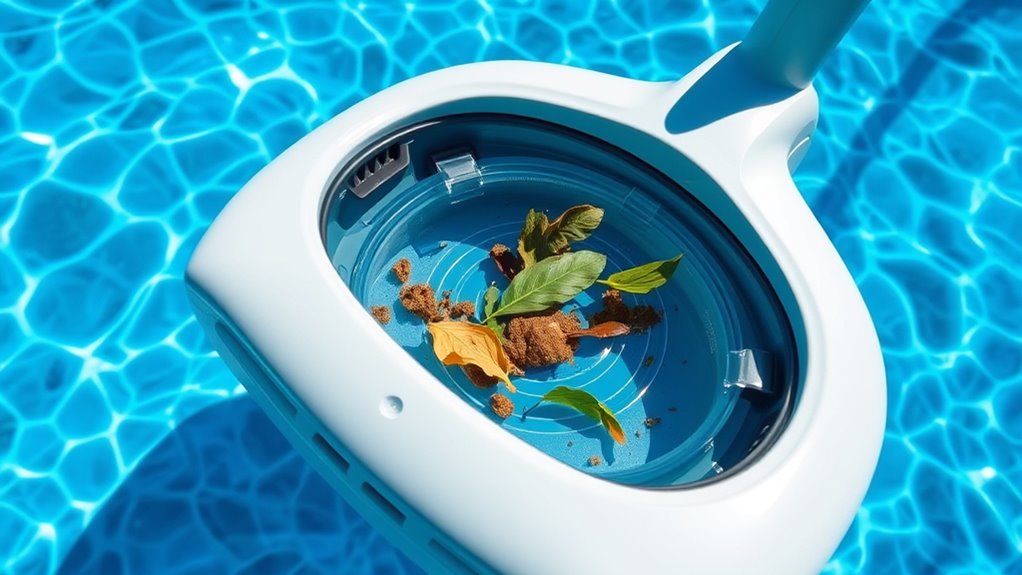
Debris collection and storage are essential for the effectiveness of suction pool cleaners. They efficiently gather dirt, leaves, and other debris, preventing clogs and maintaining water clarity. To optimize performance, consider these key points:
- Filtration System: Ensures debris is captured and contained, reducing the need for frequent manual cleaning. Regular maintenance of the filtration system can extend the life of your cleaner and improve its overall performance.
- Debris Bin Capacity: Larger bins need fewer emptyings, improving efficiency.
- Chemical Treatment Compatibility: Proper chemical balance helps prevent debris buildup and keeps the filter working smoothly.
- Energy Consumption: A well-maintained debris system minimizes energy use by reducing strain on the pump.
- Proper chemical treatment helps prevent debris buildup and keeps the filter working smoothly.
Tips for Effective Use and Maintenance
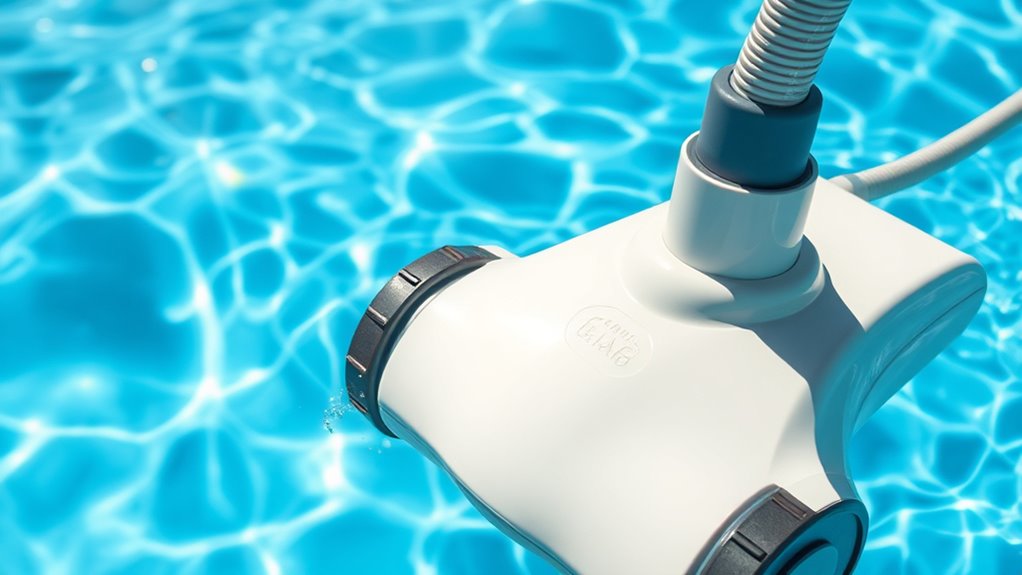
Maintaining your suction pool cleaner’s performance involves regular checks and proper care. Start by inspecting the brushes and hoses for debris or blockages that can hinder suction. Keep an eye on your pool chemistry; balanced water ensures the cleaner functions effectively and prevents equipment damage. Always follow safety protocols to protect yourself during maintenance—disconnect the pump and power supply before handling the cleaner. Regularly clean the filter and debris chamber to maintain ideal suction power. Store the cleaner in a dry, shaded area when not in use to prevent deterioration. Check for wear and tear periodically, replacing parts as needed. Proper maintenance not only prolongs your cleaner’s lifespan but also ensures it operates efficiently and safely every time.
Frequently Asked Questions
Can Suction Pool Cleaners Handle Large or Heavy Debris Effectively?
You might wonder if suction pool cleaners can handle large or heavy debris effectively. Generally, they’re designed for smaller debris, which helps maintain ideal cleaning efficiency. Larger or heavier debris can clog the system or reduce its performance, so you may need to manually remove bigger debris or consider a different cleaner. For consistent cleaning efficiency, make sure your suction cleaner is suitable for the debris size in your pool.
How Do Suction Cleaners Adapt to Different Pool Shapes and Sizes?
Imagine a river gracefully flowing through varied landscapes—that’s pool shape adaptation in action. Your suction cleaner’s flexibility allows it to navigate different pool shapes and sizes with ease. Its adaptable design molds to corners, curves, and unusual angles, ensuring thorough cleaning. This cleaner flexibility means you get a seamless, efficient clean, regardless of your pool’s unique contours, giving you a sparkling, inviting pool every time.
What Safety Precautions Should Be Taken When Operating a Suction Pool Cleaner?
When operating a suction pool cleaner, prioritize pool safety by ensuring the device is correctly connected and secure before use. Always follow manufacturer instructions and undergo proper operator training to prevent accidents. Keep children and pets away during cleaning, and turn off the cleaner before entering the pool. Regularly inspect hoses and connections for leaks or damage to maintain safe operation and avoid any potential hazards.
How Long Does a Typical Cleaning Cycle Usually Last?
Imagine your pool as a garden needing tender care; a typical cleaning cycle is like a gentle rain, lasting around 2 to 3 hours. During this time, your suction pool cleaner efficiently maintains your pool’s cleanliness, supporting pool maintenance and energy efficiency. This duration guarantees thorough debris removal without wasting energy, so you can enjoy sparkling water with less fuss and eco-friendly peace of mind.
Are There Environmental Impacts of Using Suction Pool Cleaners?
When considering the environmental impacts of suction pool cleaners, you should know that eco-friendly materials help reduce pollution. These cleaners typically don’t produce chemical runoff, unlike traditional chemical treatments. By choosing models made from sustainable materials, you minimize harmful waste. Using suction pool cleaners responsibly supports a healthier environment, preventing chemical contamination in your pool and surrounding areas, and promoting eco-conscious maintenance practices.
Conclusion
Now that you understand how suction pool cleaners work, you can see they’re like tiny underwater robots, tirelessly cleaning your pool. By harnessing the power of your pump and clever navigation, they keep your water clear without much effort on your part. Regular maintenance guarantees they run smoothly, just like tuning a musical instrument. With proper care, your cleaner will glide through debris as seamlessly as a bird soaring through the sky, keeping your pool sparkling all season long.

